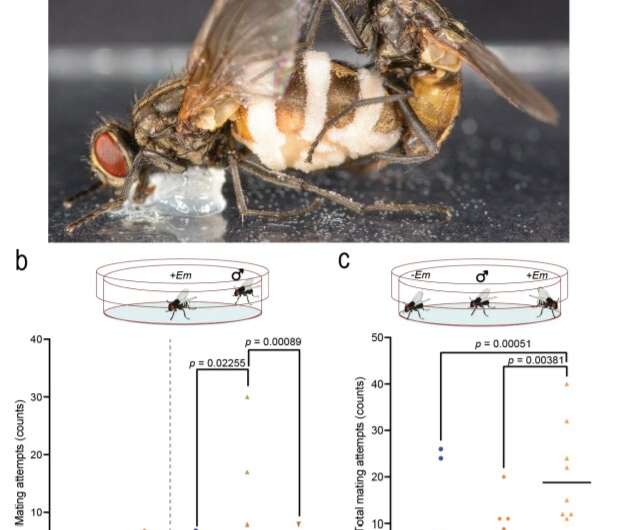A fungus that uses chemicals to trick male flies into mating with infected dead females

A combined team of researchers from the University of Copenhagen and the Swedish University of Agricultural Sciences reports that a certain fungus uses chemicals to trick male flies into mating with infected dead females. They have written a paper describing their findings and have posted it on the bioXiv preprint server.
Prior research has shown that some types of fungus can give insect victims what has become known as summit disease, in which a victim's nervous system is infected and the unwilling creature begins climbing to the highest vantage point possible. Once there, the wings are spread wide and the victim begins spewing spores. In this new effort, the researchers have found a fungus that takes summit disease one step further by having its female victims also emit chemicals that sexually attract males.
In studying the fungus Entomophthora muscae, the researchers found that it was capable of infecting other insects, primarily house flies, with summit disease. Airborne spores land on a female victim and penetrate her skin. Soon, they invade her entire body, including her nervous system and brain. Chemicals produced by the spores incite the female to begin climbing until she reaches the highest possible point, such as a leaf on a tree. Then, she opens her wings and dies. Meanwhile, the fungus covers her body with little spore-filled cannons. At some point, a male happens by, and when he touches her body, the cannons fire, filling the air with spores, ready to infect others in the vicinity.
In their lab, the researchers captured a host of infected and non-infected flies. Males were given a choice of mating with either an infected or non-infected female, and more often than not, chose the one that was infected. This suggested that the fungus was doing something to make the infected female more attractive to the male even though she was dead. In studying the dead females, the researchers found instances of unusual volatile compounds, including some chemicals called sesquiterpenes, which are not normally associated with house flies but have been found to sexually attract many types of insects, including house flies.Fungus uses zombie female beetles to infect males
More information: Andreas Naundrup et al, A pathogenic fungus uses volatiles to entice male flies into fatal matings with infected female cadavers, bioRxiv (2021). DOI: 10.1101/2021.10.21.465334
© 2021 Science X Network
No comments:
Post a Comment